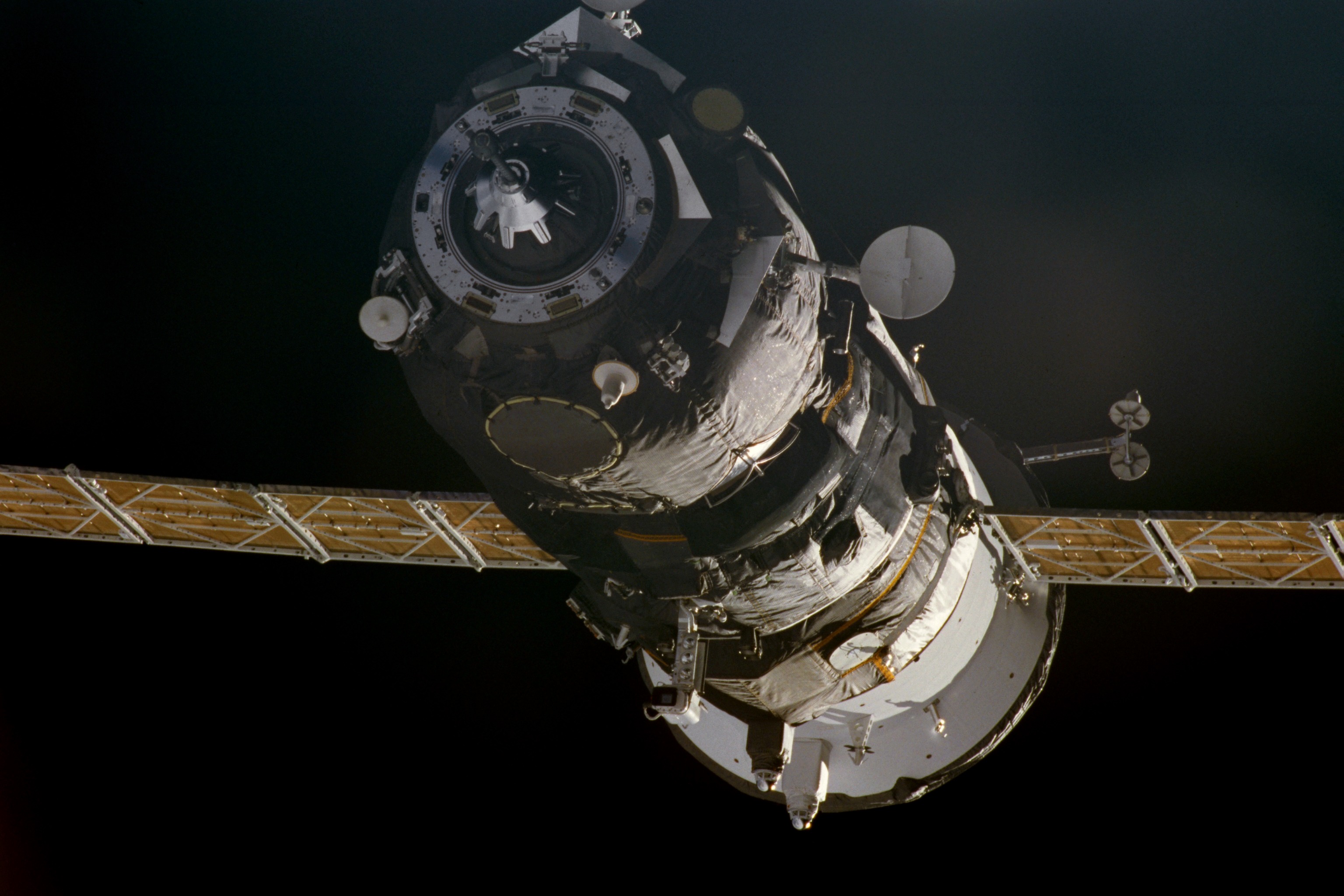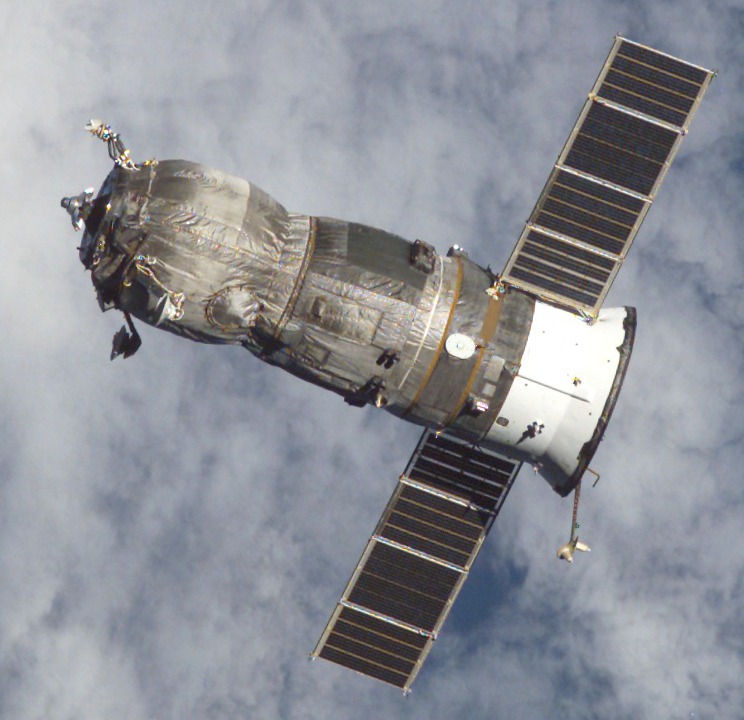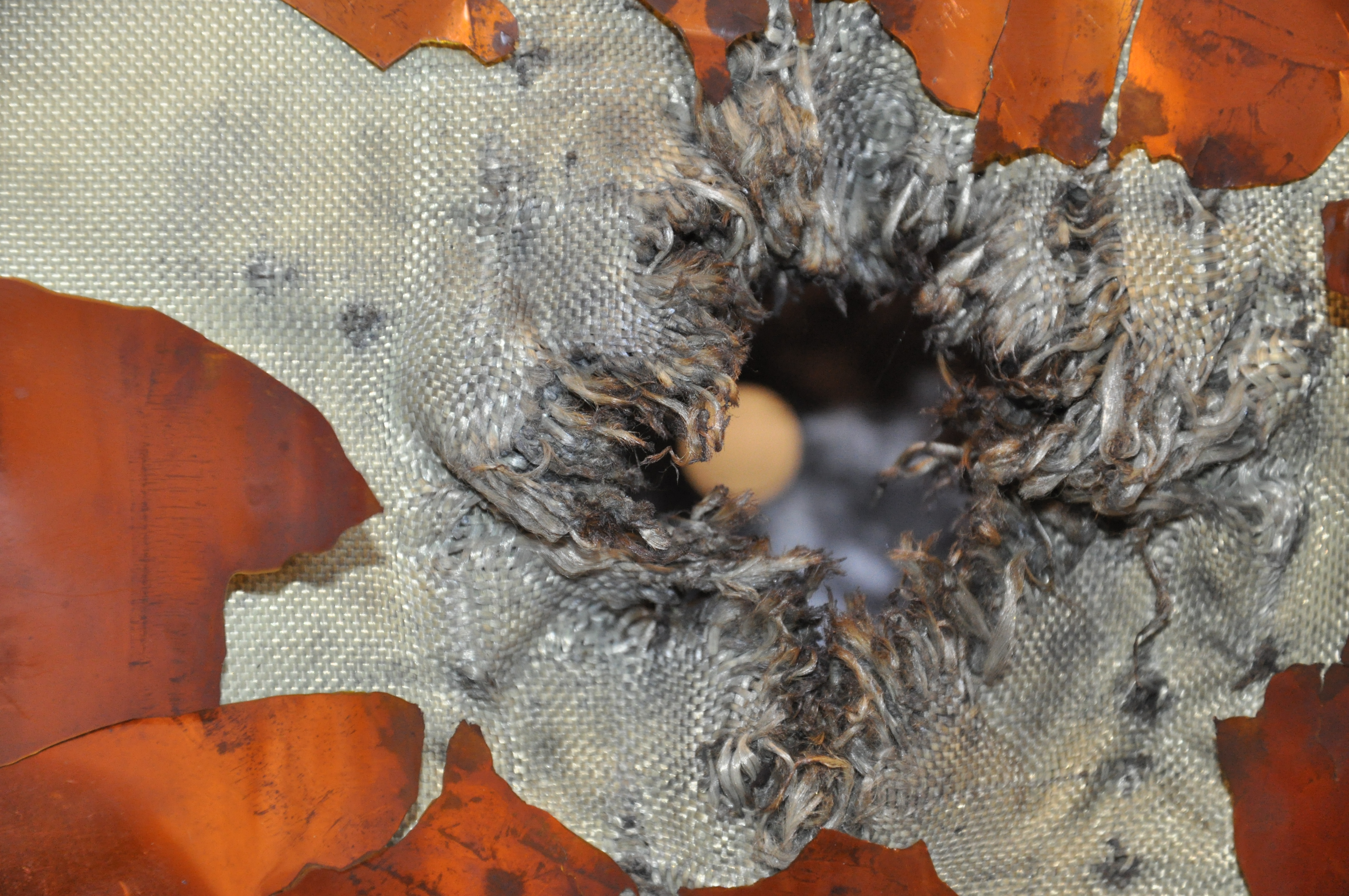|
Progress-M1
Progress-M1 (russian: Прогресс-М1, GRAU indices 11F615A55 and 11F615A70), also known as Progress 7K-TGM1, is a Russian spacecraft which is used to resupply space stations. It is a variant of the Progress spacecraft, derived from the Progress-M, but modified to carry more UDMH and N2O4 propellant for refuelling the International Space Station instead of other cargoes such as water. A Progress M1 11F615A55 spacecraft could carry up to of propellant in eight mid-section refuelling tanks, compared to the that a Progress-M of the same generation could carry. This propellant can be transferred to the Space Station's own propulsion system through fluid connectors in the docking ring, or it can alternatively be used by the Progress' thrusters to boost the station altitude or to change its orientation, or attitude, in space. In addition to propellant, the spacecraft can also carry up to (6 cubic meters volume) of supplies in its forward pressurized cargo module (including a m ... [...More Info...] [...Related Items...] OR: [Wikipedia] [Google] [Baidu] |
Progress M1-5
Progress M1-5 was the Progress spacecraft which was launched by Russia in 2001 to deorbit the fifteen-year-old ''Mir'' space station in a controlled fashion over a remote ocean area, far away from shipping lanes - otherwise Mir's orbit would have decayed uncontrolled over time (like e.g. Skylab), with debris potentially landing in a populated area. The Russian Aviation and Space Agency, Rosaviakosmos, was responsible for the mission. Launched in January 2001 after a short delay due to a problem with ''Mir'', on 27 January Progress M1-5 became the last spacecraft to dock with the station. It spent two months attached to the Kvant-1 module before deorbiting the station on 23 March 2001. ''Mir'' re-entered the atmosphere with Progress M1-5 still docked, disintegrating over the Pacific Ocean, with debris falling into the ocean at around 06:00 GMT. During the early stages of the uncrewed Progress M1-5 mission, a crewed Soyuz was placed on standby to launch in order to complete the m ... [...More Info...] [...Related Items...] OR: [Wikipedia] [Google] [Baidu] |
Progress M1-1
Progress M1-1 was a Progress spacecraft which was launched by Russia in 2000 to resupply the Mir space station. It was a Progress-M1 11F615A55 spacecraft, with the serial number 250. It was the first flight of the Progress-M1, a derivative of the Progress-M originally designed for resupplying the International Space Station, which was optimised for the transportation of fuel over pressurised cargo. Progress M1-1 was launched by a Soyuz-U carrier rocket from Site 1/5 at the Baikonur Cosmodrome. Launch occurred at 06:47:23 GMT on 1 February 2000. The spacecraft docked with Mir, which was at that time uncrewed, at 08:02:28 GMT on 3 February – the docking port used was the aft port on the ''Kvant-1'' module. It remained docked for 83 days before undocking at 16:32:43 GMT on 26 April to make way for Progress M1-2. It was deorbited at 19:26:03 GMT, and burned up in the atmosphere over the Pacific Ocean around fifty minutes later. Progress M1-1 was used to reboost Mir, which was ra ... [...More Info...] [...Related Items...] OR: [Wikipedia] [Google] [Baidu] |
Progress M1-11
Progress M1-11, identified by NASA as Progress 13P, was a Progress spacecraft used to resupply the International Space Station. It was a Progress-M1 11F615A55 spacecraft, with the serial number 260. Launch Progress M1-11 was launched by a Soyuz-U carrier rocket from Site 1/5 at the Baikonur Cosmodrome. Launch occurred at 11:58:08 UTC on 29 January 2004. Docking The spacecraft docked with the aft port of the '' Zvezda'' module at 13:13:11 UTC on 31 January 2004. It remained docked for 114 days before undocking at 09:19:29 UTC on 24 May 2004 to make way for Progress M-49. Following undocking, it remained in orbit for ten days, conducting tests of its attitude control system. It was deorbited at 09:50 UTC on 3 June 2004. The spacecraft burned up in the atmosphere over the Pacific Ocean, with any remaining debris landing in the ocean at around 10:36:25 UTC. Progress M1-11 carried supplies to the International Space Station, including food, water and oxygen for the crew and equipme ... [...More Info...] [...Related Items...] OR: [Wikipedia] [Google] [Baidu] |
Progress-M
Progress-M (russian: Прогресс-М, GRAU indices 11F615A55 and 11F615A60), also known as Progress 7K-TGM, is a Russian, previously Soviet spacecraft which is used to resupply space stations. It is a variant of the Progress spacecraft, originally built in the late 1980s as a modernised version of the Progress 7K-TG spacecraft, using new systems developed for the Soyuz-T and Soyuz-TM spacecraft. The 11F61560 variant incorporated further modernisation, with digital flight control systems replacing the earlier analogue ones. The older 11F615A55 spacecraft outlived the newer 11F615A60. The final Progress-M, Progress-M-UM, was launched on 24 November 2021. The first forty three Progress-M spacecraft were used to resupply Mir, with subsequent spacecraft flying to the International Space Station. , eighty seven spacecraft have been launched, with sixty seven using the older model, and twenty using the newer version. Launches of the 11F615A60 are continuing. One 11F615A60, Pr ... [...More Info...] [...Related Items...] OR: [Wikipedia] [Google] [Baidu] |
Progress M1-9
Progress M1-9, identified by NASA as Progress 9P, was a Progress spacecraft used to resupply the International Space Station. It was a Progress-M1 11F615A55 spacecraft, with the serial number 258. Launch Progress M1-9 was launched by a Soyuz-FG carrier rocket from Site 1/5 at the Baikonur Cosmodrome. Launch occurred at 16:58:24 UTC on 25 September 2002. Docking The spacecraft docked with the aft port of the '' Zvezda'' module at 17:00:54 UTC on 29 September 2002. It remained docked for 125 days before undocking at 16:00:54 GMT on 1 February 2003. to make way for Progress M-47 It was deorbited at 19:10:00 UTC on the same day, burning up in the atmosphere over the Pacific Ocean just six hours after the had disintegrated over Texas. Any remaining debris from Progress M1-9 landed in the ocean at around 20:00:28 UTC. Progress M1-9 carried supplies to the International Space Station, including food, water and oxygen for the crew and equipment for conducting scientific research. ... [...More Info...] [...Related Items...] OR: [Wikipedia] [Google] [Baidu] |
Progress M1-7
Progress M1-7, identified by NASA as Progress 6P, was a Progress Progress is the movement towards a refined, improved, or otherwise desired state. In the context of progressivism, it refers to the proposition that advancements in technology, science, and social organization have resulted, and by extension w ... spacecraft used to resupply the International Space Station. It was a Progress-M1 11F615A55 spacecraft, with the serial number 256. Launch Progress M1-7 was launched by a Soyuz-FG carrier rocket from Gagarin's Start, Site 1/5 at the Baikonur Cosmodrome. Launch occurred at 18:24:12 UTC on 26 November 2001. The spacecraft docked with the aft port of the ''Zvezda (ISS module), Zvezda'' module at 19:43:02 UTC on 28 November. It was unable to establish a hard dock due to debris from Progress M-45 on the docking port, which had to be removed in an unscheduled Extravehicular activity, extra-vehicular activity on 3 December 2001, after which it was able to establish a hard d ... [...More Info...] [...Related Items...] OR: [Wikipedia] [Google] [Baidu] |
Progress M1-6
Progress M1-6, identified by NASA as Progress 4P, was a Progress spacecraft used to resupply the International Space Station. It was a Progress-M1 11F615A55 spacecraft, with the serial number 255. Launch Progress M1-6 was launched on the maiden flight of the Soyuz-FG carrier rocket, flying from Site 1/5 at the Baikonur Cosmodrome. Launch occurred at 22:32:40 UTC on 20 May 2001. The spacecraft docked with the aft port of the '' Zvezda'' module at 00:23:57 UTC on 23 May 2001. Undocking It remained docked for 91 days before undocking at 06:02 UTC on 22 August 2001 to make way for Progress M-45. It was deorbited at 09:00 UTC on the same day, burning up in the atmosphere over the Pacific Ocean, with any remaining debris landing in the ocean at around 09:50 UTC. Progress M1-6 carried supplies to the International Space Station, including food, water and oxygen for the crew and equipment for conducting scientific research. See also * List of Progress flights * Uncrewed spaceflight ... [...More Info...] [...Related Items...] OR: [Wikipedia] [Google] [Baidu] |
RKK Energia
PAO S. P. Korolev Rocket and Space Corporation Energia (russian: Ракетно-космическая корпорация «Энергия» им. С. П. Королёва, Raketno-kosmicheskaya korporatsiya "Energiya" im. S. P. Korolyova), also known as RSC Energia (, RKK "Energiya"), is a Russian manufacturer of spacecraft and space station components. The company is the prime developer and contractor of the Russian crewed spaceflight program; it also owns a majority of Sea Launch. Its name is derived from Sergei Korolev, the first chief of its design bureau, and the Russian word for energy. Overview Energia is the largest company of the Russian space industry and one of its key players. It is responsible for all operations involving human spaceflight and is the lead developer of the Soyuz and Progress spacecraft, and the lead developer of the Russian end of the International Space Station (ISS). In the mid-2000s, the company employed 22,000–30,000 people. The ente ... [...More Info...] [...Related Items...] OR: [Wikipedia] [Google] [Baidu] |
Progress (spacecraft)
The Progress (russian: Прогресс) is a Russian expendable cargo spacecraft. Its purpose is to deliver the supplies needed to sustain a human presence in orbit. While it does not carry a crew, it can be boarded by astronauts when docked to a space station, hence it is classified as ''crewed'' by its manufacturer. Progress is derived from the crewed Soyuz spacecraft and launches on the same launch vehicle, a Soyuz rocket. Progress has supported space stations as early as Salyut 6 and as recently as the International Space Station (ISS). Each year there are between three and four Progress flights to the ISS. A Progress remains docked until shortly before being replaced with a new one or a Soyuz (which will use the same docking port). Then it is filled with waste, disconnected, and de-orbited, at which point it burns up in the atmosphere. Due to the variation in Progress vehicles flown to the ISS, NASA uses its own nomenclature where "ISS 1P" means the first Progress spacecra ... [...More Info...] [...Related Items...] OR: [Wikipedia] [Google] [Baidu] |
Cygnus Spacecraft
Cygnus is an expendable American cargo spacecraft developed by Orbital Sciences Corporation and now manufactured and launched by Northrop Grumman Space Systems as part of NASA's Commercial Resupply Services (CRS) program. It is launched by Northrop Grumman's Antares rocket or ULA's Atlas V and is designed to transport supplies to the International Space Station (ISS) following the retirement of the American Space Shuttle. Since August 2000, ISS resupply missions have been regularly flown by the Russian Progress spacecraft, as well as by the European Automated Transfer Vehicle, and the Japanese H-II Transfer Vehicle. With the Cygnus spacecraft and the SpaceX Dragon, NASA seeks to increase its partnerships with domestic commercial aviation and aeronautics industry. ''Cygnus'' is the Latinized Greek word for swan and a northern constellation. Development With Rocketplane Kistler unable to meet funding obligations for its K-1 launch vehicle under the terms of the COTS agree ... [...More Info...] [...Related Items...] OR: [Wikipedia] [Google] [Baidu] |
Automated Transfer Vehicle
The Automated Transfer Vehicle, originally Ariane Transfer Vehicle or ATV, was an expendable cargo spacecraft developed by the European Space Agency (ESA), used for space cargo transport in 2008–2015. The ATV design was launched to orbit five times, exclusively by the Ariane 5 heavy-lift launch vehicle. It effectively was a larger European counterpart to the Russian Progress cargo spacecraft for carrying upmass to a single destination—the International Space Station (ISS)—but with three times the capacity. The five ATVs were named after important European figures in science and engineering: '' Jules Verne'', '' Johannes Kepler'', ''Edoardo Amaldi'', ''Albert Einstein'', and ''Georges Lemaître''. Following several delays to the program, the first of these was launched in March 2008. These ATVs performed supply missions to the ISS, transporting various payloads such as propellant, water, air, food, and scientific research equipment; ATVs also reboosted the station into a ... [...More Info...] [...Related Items...] OR: [Wikipedia] [Google] [Baidu] |
Soyuz-2 (rocket)
Soyuz-2 (GRAU index 14A14) is a modernized version of the Soviet Soyuz rocket. In its basic form, it is a three-stage launch vehicle for placing payloads into low Earth orbit. Compared to the previous versions of the Soyuz, the first-stage boosters and two core stages feature uprated engines with improved injection systems. Digital flight control and telemetry systems allow the rocket to be launched from a fixed launch platform, whereas the launch platforms for earlier Soyuz rockets had to be rotated as the rocket could not perform a roll to change its heading in flight. Soyuz-2 is often flown with an upper stage, which allows it to lift payloads into higher orbits, such as Molniya and geosynchronous orbits. The upper stage is equipped with independent flight control and telemetry systems from those used in the rest of the rocket. The NPO Lavochkin manufactured Fregat is the most commonly used upper stage. Soyuz-2 rockets were first launched from Site 31 at the Baikonur Cosm ... [...More Info...] [...Related Items...] OR: [Wikipedia] [Google] [Baidu] |




